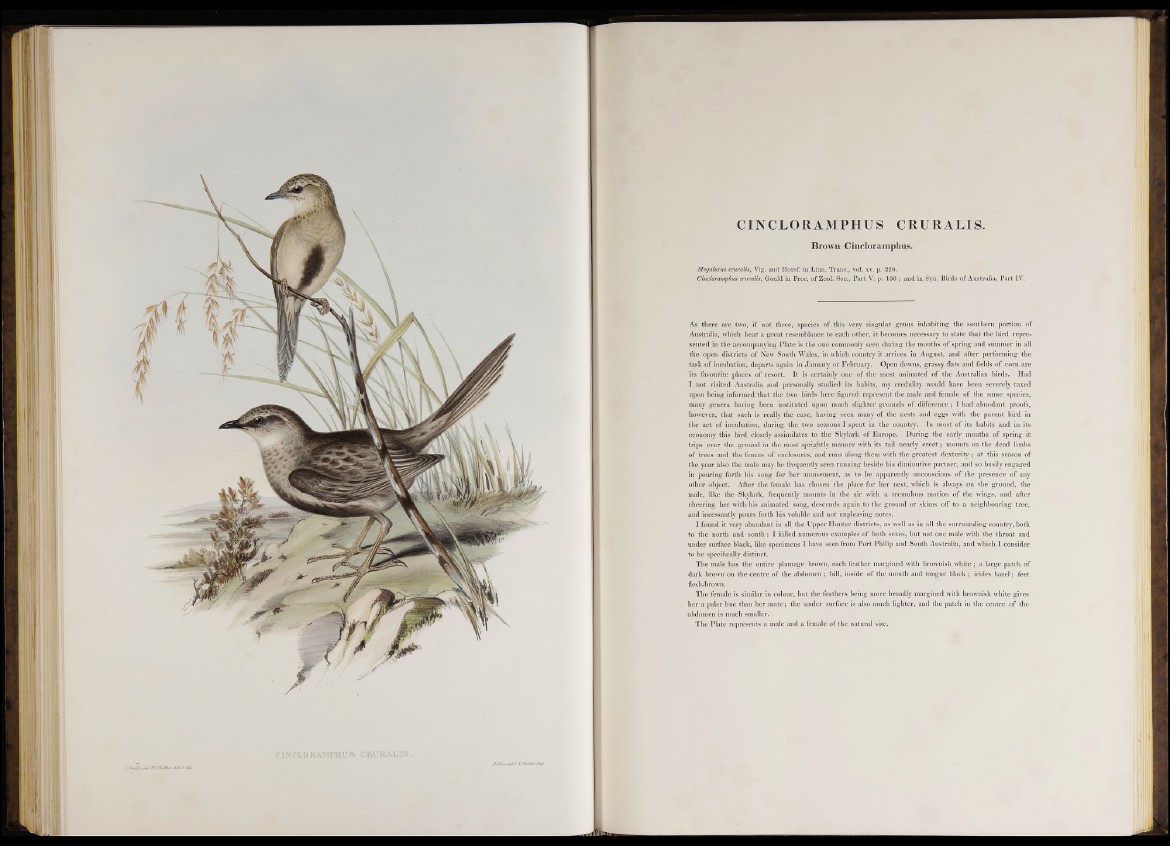
CINCLORAMPHUS CRURALIS.
Brown Cincloramphus.
Megalurus cruralis, Vig. and Horsf. in Linn. Trans., vol. xv. p. 228.
Cincloramphus cruralis, Gould in Proc. of Zool. Soc., Part V. p. 150; and in Syn. Birds of Australia, Part IY.
As there are two, if not three, species of this very singular genus inhabiting the southern, portion o f
Australia, which bear a great resemblance to each other, it becomes necessary to state th at the bird represented
in the accompanying Plate is the one commonly seen during the months o f spring and summer in all
the open districts of New South Wales, in which country it arrives in August, and after performing the
ta.sk o f incubation, departs again in January or February. Open downs, grassy flats and fields o f corn are
its favourite places o f resort. I t is certainly one p f the most animated o f the Australian birds. Had
I not visited Australia and personally studied its habits, my credulity would have been severely taxed
upon being informed th at the two birds here figured represent the male and female o f the same species,
many genera having been instituted upon much slighter grounds o f difference; I had abundant proofs,
however, th at such is really the case, having seen many o f the nests and eggs with the parent bird in
the act o f incubation, during the two seasons I spent in the country. In most o f its habits and in its
economy this bird closely assimilates to the Skylark o f Europe. During the early months o f spring it
trips over the ground in the most sprightly manner with its tail nearly e r e c t; mounts on the dead limbs
of trees and the fences of enclosures, and runs along them with the g reatest d e x te rity ; a t this season of
the year also the male may be frequently seen running beside his diminutive partner, and so busily engaged
in pouring forth his song for h e r amusement, as to be apparently unconscious o f the presence o f any
other object. After the female has chosen the place for her nest, which is always on the ground, the
male, like the Skylark, frequently mounts in the air with a tremulous motion o f the wings, and after
cheering her with his animated song, descends again to the ground or skims off to a neighbouring tree,
and incessantly pours forth his voluble and not unpleasing notes.
I found it very abundant in all the Upper H unter districts, as well as in all the surrounding country, both
to the north and south : I killed numerous examples o f both sexes, but not one male with the throat and
under surface black, like specimens I have seen from P o rt Philip and South Australia, and which I consider
to be specifically distinct.
The male has the entire plumage brown, each feather margined with brownish w h ite ; a large patch of
dark brown on the centre of the abdomen ;;|tp l, inside of the mouth and tongue black ; irides hazel; feet
flesh-brown.
The female is similar in colour, but the feathers being more broadly margined with brownish white gives
her a paler hue than her m ate ; the under surface is also much lighter, and the patch in the centre o f the
abdomen is much smaller.
The Plate represents a male and a female of the natural size.